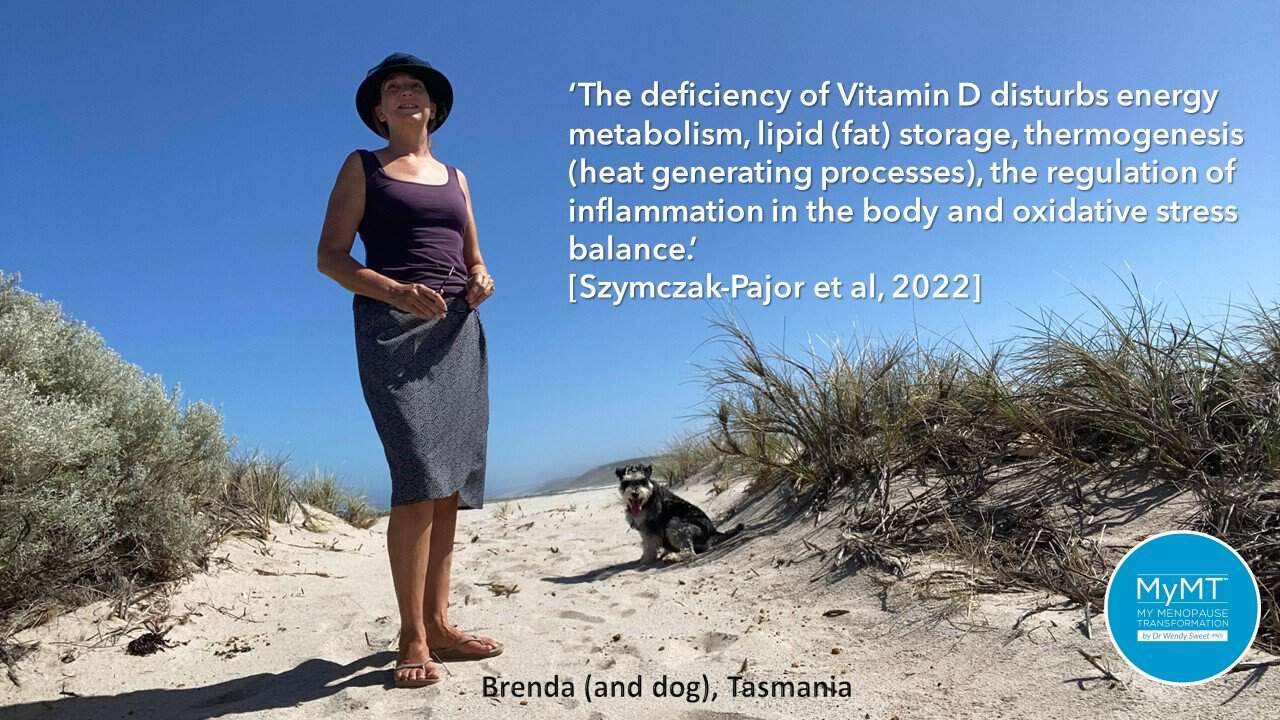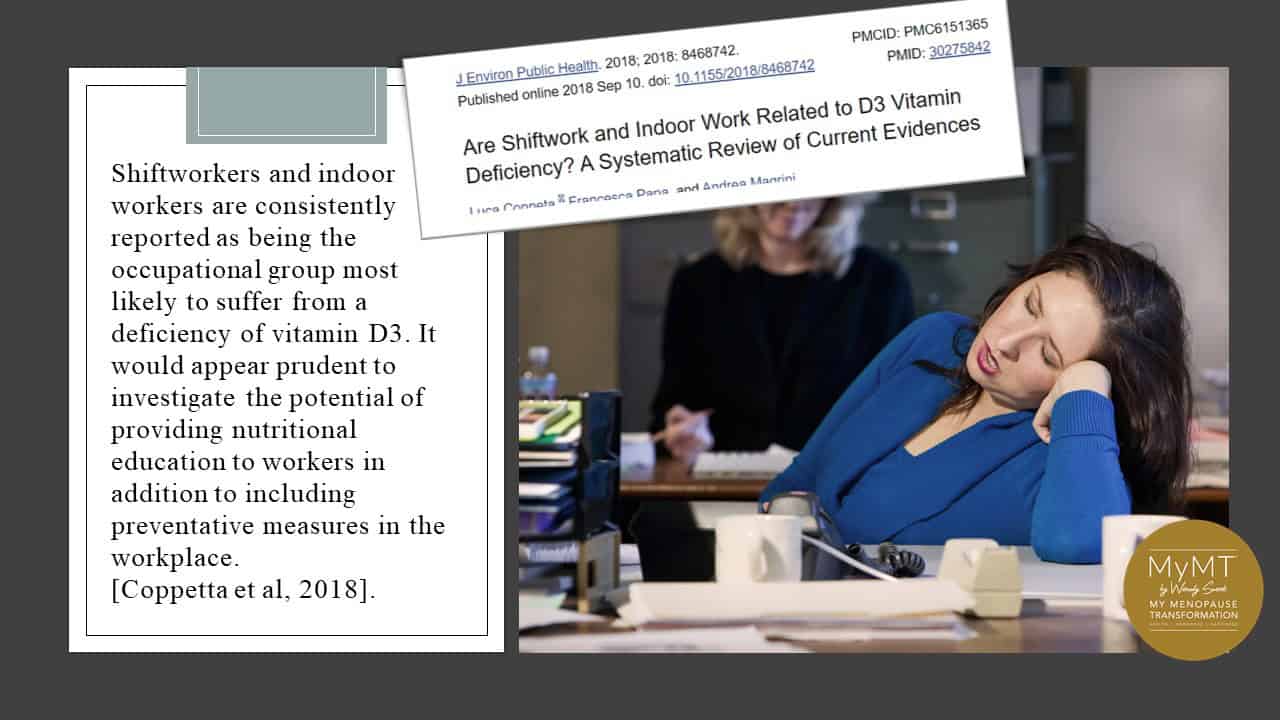If there’s one thing I wish I had been able to help my late-mother with, it would be her sleep. Or rather, her lack of it. As I read the women’s health and ageing literature whilst undertaking my doctoral studies, there is no question that if we are going to live healthy, long lives, then sleep quality and quantity matters.
I think many of us already know that healthy sleep is not only necessary for maintaining our physical and psychological health. But as we move into post-menopause, [when periods have stopped for a year or more], you may not realise that your changing sleep patterns are not just related to your changing reproductive hormones, but to your levels of Vitamin D too.
I love everything about the photo of my cousin, Bridget, in the banner below. In post-menopause now, she looks healthy. Normally living in Italy where the winters are long and dark, there she is on a Perth beach late last year soaking up the sun. Storing it in her body for her return to Italy and a long, sun -deprived winter.

Vitamin D is a unique, fat-soluble vitamin, that is now recognised as being responsible for a host of immune responses in the body, including helping to regulate our sleep-wake cycle. It’s not only a vitamin, but is now known to be a hormone – a powerful chemical messenger that is involved in numerous functions in the body.
I’ve spoken about Vitamin D in relation to your changing skin as you move into your post-menopause years (when periods have ceased for a year or more), but you may not know that Vitamin D receptors are also expressed in the parts of your brain that regulate your sleep-wake cycle.
When Vitamin D status (measured as serum 25(OH)D is low (less than 20ng/mL or 50 nmol/L), research suggests that this can seriously impair sleep. As such, this can lead women in post-menopause down the slippery slope towards heart disease and of course, weight gain.
For most fair-skinned people, 30 minutes a day of natural sunlight exposure (not in the heat of the day) can initiate the release of 50,000 IU (International Units or 1.25mg) of Vitamin D into the circulation within 24 hours of exposure. In darker skinned people, this amount of time yields around 20-30,000 IU.

For nearly a decade now, I’ve spoken about the importance of Vitamin D in the MyMT™ programmes . Whether women are experiencing insomnia or not, sleep quality and duration is closely linked to our symptoms (and weight gain) in menopause as well as levels of Vitamin D.
If we don’t get sleep under control, and our gut health, which, if women have IBS, can impair the role of calcium absorption if Vitamin D levels are low. Then throughout menopause and into post-menopause, symptoms may become worse.
Furthermore, if you are someone who is experiencing joint pain and/or fibromyalgia, this can also be due to changing Vitamin D levels too. Research from Okura et al. (2008), reports that chronic pain is also a marker of Vitamin D deficiency and individuals with chronic pain and sleep deprivation is reported to increase inflammatory markers.
Vitamin D deficiency also increases the risk of auto-immune disease as well as respiratory diseases. Those of you doing shift-work or those of you working long hours in indoor jobs, please take note.

For years, it was thought that Vitamin D levels were ‘just’ related to bone health, however, now recognised as a hormone, this means it has a far-reaching effect on the health of nearly every organ in our body. Because we have oestrogen receptors all over our body, when oestrogen levels become low during our menopause transition, then it’s a pretty safe bet, that Vitamin D levels will undoubtedly be low. My advice to you? Get your levels tested when you can.
What if I can’t get enough Vitamin D from sunlight?
With numerous nurses and other shift workers on my programmes as well as women in the Northern Hemisphere who are going into the winter months, this question is a regular one. Vitamin D is not found in many foods but the following foods provide good sources for women in post-menopause.
- Fatty fish like cod, trout, salmon, mackerel and sardines.
- Butter
- Milk – Food manufacturers also fortify (add) Vitamin D to milk. Whilst I don’t have a lot of milk intake on my programmes because of the high sugar content of milk, if Vitamin D is low or if osteoporosis is present, then women are often recommended to have low-fat milk by their medical provider.
- Egg yolks
- Cod liver oil

In many diseases of older age for both men and women, there is often low Vitamin D status which commences in mid-life. For women, the change in Vitamin D status generally begins during menopause.
Part of the reason for lower Vitamin D levels hitting women during menopause, is our changing oestrogen levels. Oestrogen receptors can be found around our body, including in our epithelial tissue (skin), so during our menopause transition, when we begin to lose oestrogen receptor cells, it’s not just the ovaries that are affected. Other oestrogen-attracting cells are too.
What this means is that women (both fair-skinned and dark-skinned women) don’t synthesize (produce) Vitamin D very well in menopause. It also means that night shift-workers get a double-whammy of losing oestrogen and losing exposure to Vitamin D because they have less available sunlight hours if they sleep all day.

Menopause is one the most crucial stages in a female’s life and for years, I’ve been talking to women on my programmes about getting their Vitamin D levels tested. Many continue to tell me that Doctors are somewhat reluctant to do this.
Hence, I was heartened when new research came my way recently stating that numerous education gaps remain in relation to the health-related needs of females during menopause. [Rostami-Moez et al., 2023]. One of these research gaps relates to Vitamin D.
Hormonal fluctuations, excessive clothing covering, sunscreen use, changes in body fat composition, a vitamin D-deficient diet, and a sedentary lifestyle can all predispose menopausal and postmenopausal women to Vitamin D deficiency.
But there is something else as well and that is menopause itself. The changing hormonal profile as well as changing skin health, marks a significant shift in vitamin D requirements during menopause. This is why evidence suggests that vitamin D deficiency is linked to various menopausal health conditions, such as vasomotor symptoms (hot flushes), poor liver and gut health and of course, musculo-skeletal disorders. [Hassanein et al, 2023].
Women on the 12 week MyMT™ programmes learn very quickly about the relevance of Vitamin D in our symptom and weight management, especially as we move into post-menopause. I hope that you can join me sometime to find out why.
If you aren’t sure about joining me, then please start with my Symptoms Quiz on the website and have a listen to what I have to tell you about the Masterclass on Menopause which you also may like to get. This is only NZ$15 and I explain all about it in the brief video below.
Dr Wendy Sweet (PhD), MyMT™ Founder & Coach/ Member: Australasian Society of Lifestyle Medicine.
References:
Coppeta, L., Papa, F., & Magrini, A. (2018). Are Shiftwork and Indoor Work Related to D3 Vitamin Deficiency? A Systematic Review of Current Evidences. Journal of Environmental and Public Health, 8468742. https://doi.org/10.1155/2018/8468742
Gao, Q., Kou, T., Zhuang, B., Ren, Y., Dong, X., & Wang, Q. (2018). The Association between Vitamin D Deficiency and Sleep Disorders: A Systematic Review and Meta-Analysis. Nutrients, 10(10), 1395. https://doi.org/10.3390/nu10101395
Hassanein MM, Huri HZ, Baig K, Abduelkarem AR. Determinants and Effects of Vitamin D Supplementation in Postmenopausal Women: A Systematic Review. Nutrients. 2023 Jan 29;15(3):685. doi: 10.3390/nu15030685.
Iruzubieta P, Terán Á, Crespo J, Fábrega E. Vitamin D deficiency in chronic liver disease. World J Hepatol. 2014 Dec 27;6(12):901-15. doi: 10.4254/wjh.v6.i12.901.
Nagai, M., Hoshide, S., & Kario, K. (2010). Sleep duration as a risk factor for cardiovascular disease- a review of the recent literature. Current cardiology reviews, 6(1), 54–61. https://doi.org/10.2174/157340310790231635
Okura K., Lavigne G., Huynh N., Manzini C., Fillipini D., & Montplaisir J. (2008). Comparison of sleep variables between chronic widespread musculoskeletal pain, insomnia, periodic leg movements syndrome and control subjects in a clinical sleep medicine practice. Sleep Med. 9(4):352-61. doi: 10.1016/j.sleep.2007.07.007. Epub 2007 Sep 4. PMID: 17804292.
Rostami-Moez M, Masoumi SZ, Otogara M, Farahani F, Alimohammadi S, Oshvandi K. Examining the Health-Related Needs of Females during Menopause: A Systematic Review Study. J Menopausal Med. 2023 Apr;29(1):1-20. doi: 10.6118/jmm.22033.

